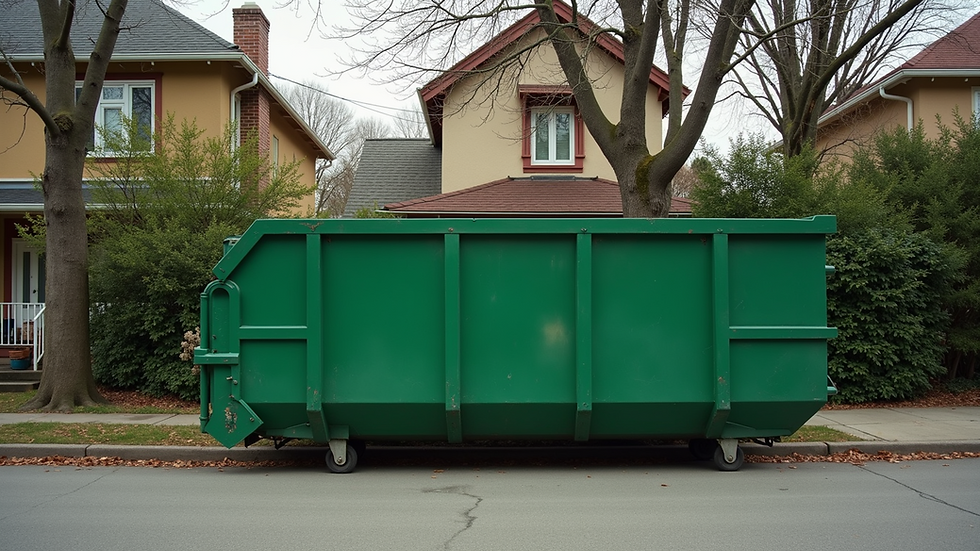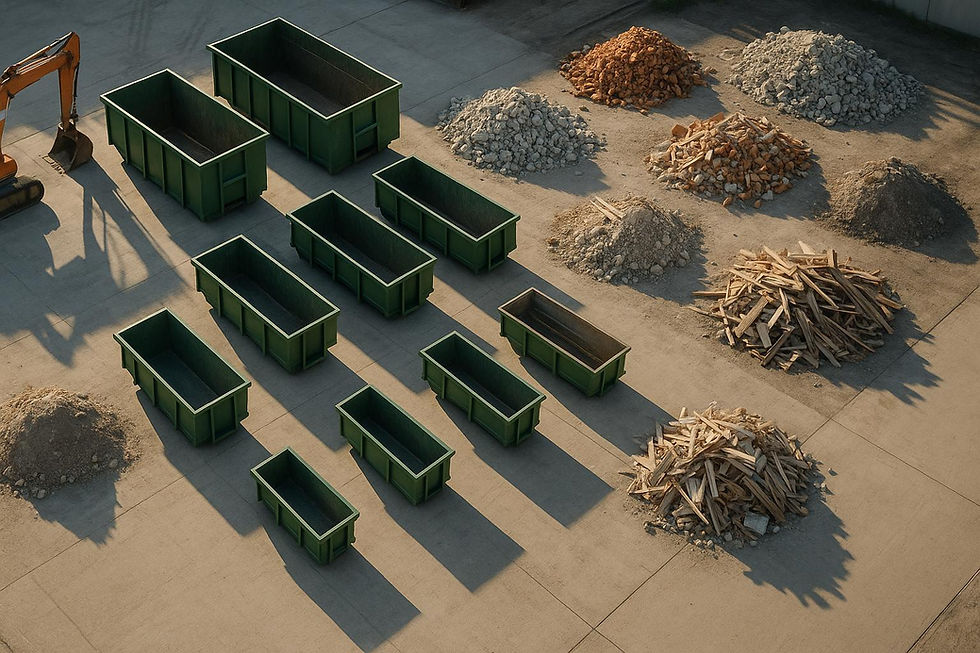7 Essential Tips for Choosing the Right Dumpster Size
- Gregory Cunningham
- Mar 3
- 7 min read
Updated: Apr 28
Picking the right dumpster size is crucial to avoid extra costs and project delays. Here’s what you need to know:
- Small Projects (10–15 yards): Ideal for minor renovations or cleanouts. Holds 3–5 pickup loads.
- Medium Projects (20 yards): Best for kitchen remodels or roofing jobs. Fits 6 pickup loads.
- Large Projects (30–40 yards): Perfect for construction or major cleanouts. Fits 9–12 pickup loads.
- Weight Matters: Check weight limits (1–5 tons) to avoid fees.
- Plan Placement: Ensure flat ground, clear access, and permits if needed.
- Material Type: Heavy items like concrete require special bins.
Start by estimating your project’s waste volume, then choose a size slightly larger to avoid overloading. Renting the right dumpster saves time, money, and hassle.
Dumpster Sizes and Their Best Uses
Size Options and Space Requirements
Dumpster sizes play a key role in planning for both space and waste capacity. Roll-off dumpsters are available in six standard sizes - 10, 12, 15, 20, 30, and 40 cubic yards.
Here’s a quick overview of common roll-off dumpster sizes, along with their dimensions, weight limits, and approximate capacities:
Size | Dimensions | Weight Limit | Capacity |
10 yard | 14' x 7.5' x 3.5' | 1–2 tons | About 3 pickup loads |
12 yard | 14' x 7.5' x 4' | 1–2 tons | 3–4 pickup loads |
15 yard | 16' x 7.5' x 4.5' | 1–2 tons | 4–5 pickup loads |
20 yard | 22' x 7.5' x 4.5' | 2–3 tons | 6 pickup loads |
30 yard | 22' x 7.5' x 6' | 2–4 tons | 9 pickup loads |
40 yard | 22' x 7.5' x 8' | 4–5 tons | 12 pickup loads |
These dimensions are useful when planning placement and logistics. For smaller commercial spaces, front-load dumpsters provide a more compact option. Make sure to leave around 60 feet of clearance for safe placement and easy loading.
Best Projects for Each Size
Choosing the right dumpster size for your project can save time and hassle. According to City Suburban Service, Inc., a 10-yard dumpster is ideal for small residential cleanups, minor kitchen or bathroom renovations, and light commercial projects. It can hold 50–70 trash bags, with rental costs ranging from $349 to $595.
The 20-yard dumpster is a popular choice, perfect for medium-sized renovations and larger cleanouts. It can handle up to 2–3 tons of waste.
For large-scale construction or major commercial cleanouts, 30- and 40-yard dumpsters are the way to go. A 40-yard dumpster, for instance, can hold the equivalent of about twelve pickup loads.
For ongoing commercial waste management, front-load dumpsters offer tailored options:
- 2-yard: Holds about 12 trash bags, great for small businesses.
- 4-yard: Works well for medium-sized retail spaces.
- 6-yard: A good fit for restaurants and larger stores.
- 8-yard: Designed for businesses with high waste volumes.
If you’re unsure which size to choose, consulting with rental experts can provide clarity.
Calculate Your Waste Volume
Measure Your Project Size
To estimate waste volume, start by measuring the size of your project. WasteWorks USA emphasizes that proper measurement can help you avoid extra charges.
For home renovations, measure the dimensions of the rooms or areas involved. Use a tape measure for smaller spaces and a measuring wheel for larger ones.
Here’s a quick way to visualize waste volume:
- A standard washing machine equals about 1 cubic yard.
- A typical wheelbarrow holds 2–3 cubic feet (around 1/9 of a cubic yard).
- A full-size pickup truck can carry 2–3 cubic yards.
After gathering your measurements, convert them into cubic yards to better understand the capacity you'll need.
Convert to Cubic Yards
To convert your measurements to cubic yards, multiply the length, width, and height (in feet) of the space and divide the total by 27 (since 1 cubic yard equals 27 cubic feet).
Here’s a guide to common dumpster sizes and their capacities:
Dumpster Size | 33-Gallon Trash Bags | Wheelbarrow Loads | Pickup Truck Loads |
10 yard | 50–70 | 80–100 | 3 |
20 yard | 110–130 | 170–190 | 6 |
30 yard | 170–190 | 260–280 | 9 |
40 yard | 230–250 | 350–370 | 12 |
"When in doubt, it's always better to rent a slightly larger dumpster than a smaller one, as overloading a dumpster can lead to additional fees." - WasteWorks USA
For precise calculations, professional tools like the LEED Construction and Demolition Waste Calculator can be helpful. Keep in mind that different materials take up varying amounts of space. For example, concrete and metals are much denser than wood or yard waste. Always add a safety margin to account for unexpected materials or changes in your project.
What to Check Before Renting
Types of Waste Allowed
Before renting a dumpster, make sure you understand what types of waste are permitted. This can vary depending on local regulations and the dumpster provider. Waste Connections highlights that acceptable materials often differ by location. Generally, you can dispose of non-hazardous household waste, construction debris, yard waste, bulky furniture, and appliances. However, items like mattresses, electronics, and tires may need special handling. To comply with guidelines, separate recyclable materials - such as paper, cardboard, and metal - from regular trash.
Material Type | Approx. Weight per Cubic Yard | Notes |
Construction Debris | 350 lbs | Might require a dedicated bin |
Furniture | 300 lbs | Check for upholstery limits |
Brush/Limbs | 250 lbs | May fall under organic rules |
Concrete | 4,000 lbs | Needs a heavy-duty container |
After confirming what materials you can throw away, be sure to review weight limits for the dumpster size you plan to rent.
Weight Limits
Dumpsters come with specific weight limits to ensure safe transport and proper pricing. Here’s a breakdown of typical weight limits:
- 10-yard dumpster: 1–2 tons (2,000–4,000 pounds)
- 20-yard dumpster: 2–3 tons (4,000–6,000 pounds)
- 40-yard dumpster: 4–5 tons (8,000–10,000 pounds)
Most roll-off trucks can carry up to 10 tons (20,000 pounds). To ensure safety, companies often limit weight to around 300–500 pounds per cubic yard.
Permits and Rules
Lastly, check if you need permits for your dumpster placement. Dumpsters on private property usually don’t require permits, but those placed on public streets or sidewalks often do. Right-of-way permits can take 3–5 days to process. If you live in a homeowners association, written approval might also be required, even if city permits aren’t. For special cases - like placing a dumpster in a parking lot or park - additional permits may be necessary. Always consult your local Building and Application department to confirm the rules and avoid fines or removal orders.
How to Select A Dumpster Size
Common Rental Mistakes to Avoid
After determining the right size and limits for your dumpster, it’s important to steer clear of common rental mistakes that could disrupt your project.
Getting a Too-Small Dumpster
Choosing a dumpster that's too small can lead to extra pickups, longer rental periods, and higher expenses. A little planning can help you sidestep these problems.
Consequence | Impact | How to Avoid |
Extra Pickups | Increased transport fees | Add a 15-20% capacity buffer |
Project Delays | Higher rental costs | Opt for a larger size if unsure |
Safety Concerns | Uneven weight risks | Distribute loads evenly |
Spillage Risks | Environmental hazards | Monitor fill levels |
Missing Size and Weight Limits
Exceeding weight limits can rack up hefty fees. For instance, James G. Grant Co. charges $150 per ton over the specified limit. Keep in mind, different materials have vastly different weights per cubic yard:
- Construction debris: 350 pounds
- Concrete: 4,000 pounds
- Yard waste: 250 pounds
Knowing these differences can save you from unexpected costs.
Overlooking Permit Requirements
Ignoring permit rules can lead to serious setbacks. Violations may result in:
- Delivery refusals and trip fees (e.g., Budget Dumpster charges for these)
- Immediate removal orders
- Fines from local authorities
- Delays in your project timeline
To avoid these issues:
- Check your local placement regulations.
- Submit permit applications well in advance.
- Display permits clearly on-site.
- Follow all placement guidelines to stay compliant.
Steps to Pick Your Dumpster Size
Check Space Requirements
After estimating your waste volume, measure the available area to ensure the dumpster can be placed safely. Look for a flat, accessible spot that can handle the dumpster's size and weight.
Here's a quick breakdown of common dumpster sizes and their uses:
Dumpster Size | Dimensions | Ideal For |
10 Cubic Yards | 14' x 7.5' x 3.5' | Small renovations, garage cleanouts |
20 Cubic Yards | 22' x 7.5' x 4.5' | Kitchen remodels, roofing jobs |
30 Cubic Yards | 22' x 7.5' x 6' | Larger renovations, community projects |
40 Cubic Yards | 22' x 7.5' x 8' | Big construction or commercial cleanouts |
Make sure to account for:
- A 3-foot buffer from nearby buildings or structures
- Clear overhead space free of power lines
- Solid, level ground to support the weight
- Easy access for delivery and pickup trucks
If you're unsure about the size, reaching out to a professional can help you make a confident choice.
Ask Expert Advice
When speaking with waste management professionals, be ready to discuss:
- Your project timeline and key phases
- Types and weights of materials you'll dispose of
- Details about access points, surface conditions, or obstacles
- Local permit and placement rules
These details will help them recommend the best dumpster size for your needs.
Choosing the Right Dumpster Size
Picking the correct dumpster size is key to managing waste efficiently and saving money. It's better to slightly overestimate your needs than to deal with overflow fees or the hassle of renting multiple units.
Here are the main factors to consider:
Factor | What to Think About | Why It Matters |
Project Scale | From small renovations to large construction | Helps determine the size you'll need |
Material Type | Light debris or heavy materials | Impacts weight limits and capacity |
Site Access | Driveway space and overhead clearance | Affects the size of the dumpster you can use |
Local providers like Dump & Go can offer tailored advice based on your specific project. They also ensure compliance with local rules to make the process smoother.
To make the best decision, have these details ready:
- A clear timeline and project phases
- The types of materials you’ll be disposing of
- Measurements for the site and access points
- Any local permits you might need
Choosing the right size isn’t just about fitting your waste - it's about getting the most value while staying mindful of compliance and logistics.



Comments